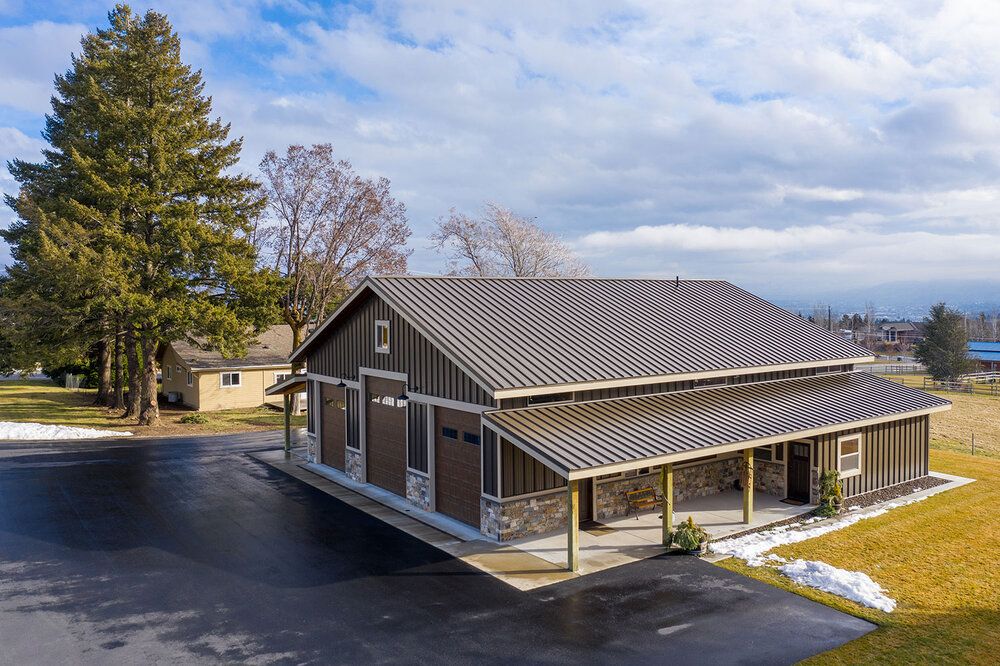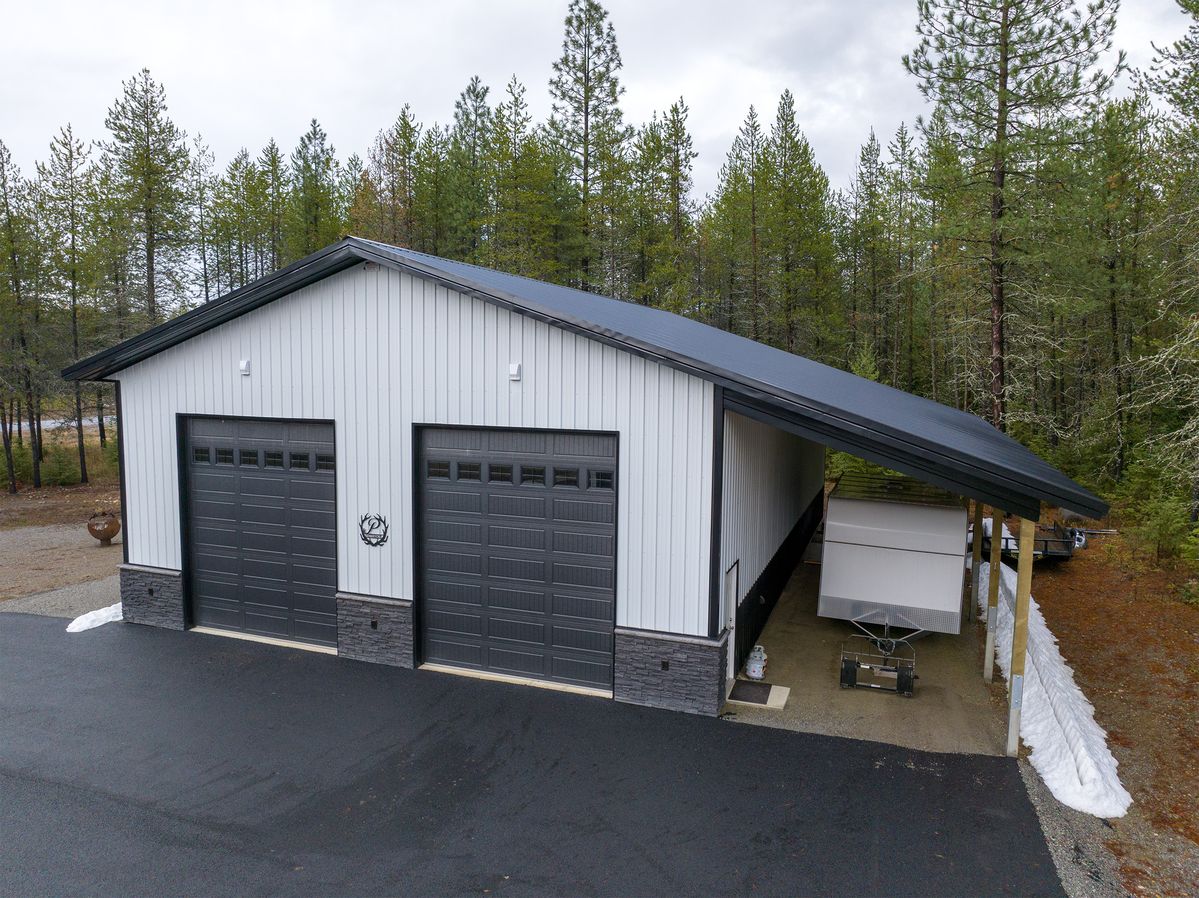Planning a new barn, shop, or storage space? The big question is steel building or pole barn. Each has clear trade-offs, so the best choice depends on your budget, goals, and how long you need it to last.
Which is better: steel building or pole barn?
Steel buildings can last 50+ years with minimal upkeep. Pole barns are cheaper and quicker to build, but usually last 20–30 years before major repairs.
Key Takeaways
- Steel Buildings: Stronger, last 50+ years, low maintenance, higher upfront cost.
- Pole Barns: Cheaper, faster to build, 20–30 year lifespan, more upkeep.
- Best Choice: Steel if you want long-term durability, pole barn if you need quick, budget-friendly space.
What Is a Steel Building?

Strong Bones, Modern Look
A steel building is exactly what it sounds like, framed and built with steel. Think clean lines, modern style, and unmatched strength.
Built for Weather and Wear
Steel buildings handle storms, snow, and heat without constant patchwork. Instead of frequent repairs, you get a structure designed to endure.
Space Without Limits
Because steel carries its own weight, you get wide, open interiors without posts in the way. Ideal for workshops, storage, or even recreational setups.
Low Maintenance, High Payoff
Steel won’t rot, warp, or need repainting every year. You spend less on upkeep and more time using your space.
What Is a Pole Barn?
The Basics: A pole barn uses posts set deep in the ground for support, often without a traditional concrete foundation. This makes them faster and cheaper to build.
Why People Choose Them: Pole barns are cost-effective for storage, parking, or workshops. They deliver usable space without stretching your budget.
Style Meets Function: Modern pole barns aren’t just plain sheds. With metal siding, windows, and optional living areas, they balance affordability with function.
Cost Comparison: Steel Building vs Pole Barn
Upfront Costs: Pole barns usually cost less upfront thanks to simpler design and materials. Steel buildings require a bigger investment because of heavier framing and construction.
Long-Term Value: Steel buildings often save more over time. They resist rot, pests, and weather damage, while pole barns usually need more repairs and upkeep.
Which Fits Your Budget? A pole barn works if you need something quick and affordable. Steel costs more upfront but pays back with decades of durability and fewer repairs.
Durability and Lifespan
Steel Buildings: Built to Outlast
Steel is the heavyweight champ here. It resists rot, pests, and warping, which means fewer surprise repairs. With proper upkeep, you’re looking at a structure that can easily push past 50 years.
Pole Barns: Solid but Shorter Game
Pole barns hold up well, but wood posts are vulnerable to moisture and termites. Even treated lumber can slowly break down over time. Expect a 20–30-year window before big repairs start calling.
Which One’s the Smarter Flex?
If you want a long-term play, steel gives you less drama and more peace of mind. Pole barns are cheaper upfront, but might tap your wallet later. Think of it as choosing between a fast-fashion hoodie and a tailored jacket—the jacket just lasts longer.
Maintenance Requirements
Steel Buildings
Steel buildings are basically low-drama. Wash them down now and then, tighten a bolt if it’s loose, and you’re golden. Rust can show up if you slack, but a quick coat of paint or sealant keeps the shine strong.
Pole Barns
Pole barns need a little more TLC. Wood posts can warp, rot, or invite bugs if they’re not protected. Expect to re-treat or replace sections over time, which adds upkeep compared to steel.
Customisation and Design Options
Steel Buildings: Sleek and Structured
Steel metal roofing gives steel buildings a clean, modern flex. Think sharp lines, big spans, and almost endless finishes – perfect if you want your space to look professional without screaming “barn.”
Pole Barns: Rustic with Wiggle Room
Pole barns are more laid-back. You can pick siding, roofing, and layouts that lean toward farmhouse or functional. They’re easier to tweak if you want something simple but still personal.
Which One Fits You?
If you’re chasing that polished, long-term drip, steel is your play. If budget-friendly with custom charm is more your vibe, pole barns hold their own.
Energy Efficiency and Insulation
Steel Buildings: Steel locks in tight. Pair it with insulation and you’ve got a structure that holds heat in winter and stays cooler in summer. That means lower bills and fewer thermostat battles.
Pole Barns: Pole barns breathe more, which can be good for airflow but not for energy savings. To keep them efficient, you’ll need to add proper insulation, especially if you’re using the space year-round.
Best Uses for Steel Buildings vs Pole Barns
Steel Buildings
Steel flexes as the go-to for big commercial moves, auto shops, and warehouses. You get serious durability, wide spans, and low upkeep. If you’re building for decades of heavy use, steel’s your cheat code.
Pole Barns
Pole barns shine for farms, garages, and backyard storage. They’re quick to put up, easier on the budget, and solid for lighter workloads. Perfect if you want space without the luxury price tag.
Pros and Cons at a Glance
Steel Building: Pros
Strong, sleek, and low-maintenance. It laughs at harsh weather and stays sharp for decades. Quick builds mean you’re not living in a construction zone forever.
Steel Building: Cons
Upfront cost can sting, and design options lean more industrial. Not the best if you’re chasing farmhouse vibes.
Pole Barn: Pros
Budget-friendly and flexible on style. You can flex wood siding, metal panels, or a mix. Great for storage or casual spaces.
Pole Barn: Cons
Shorter lifespan and higher upkeep. Wood posts invite rot, pests, and more repair runs over time.
So, Which Is Better?
Steel Building
If you’re playing the long game, steel’s your cheat code. It’s stronger, shrugs off storms, and barely asks for maintenance. Think of it as the Rolex—built tough, timeless flex.
Pole Barn
Pole barns win if you’re chasing budget-friendly speed. They’re quick to put up and get the job done without draining your wallet. More backyard BBQ than black-tie gala.
The Call
Your move depends on priorities. Need strength and low upkeep? Go steel. Want fast, affordable shelter? Pole barn’s your guy.

